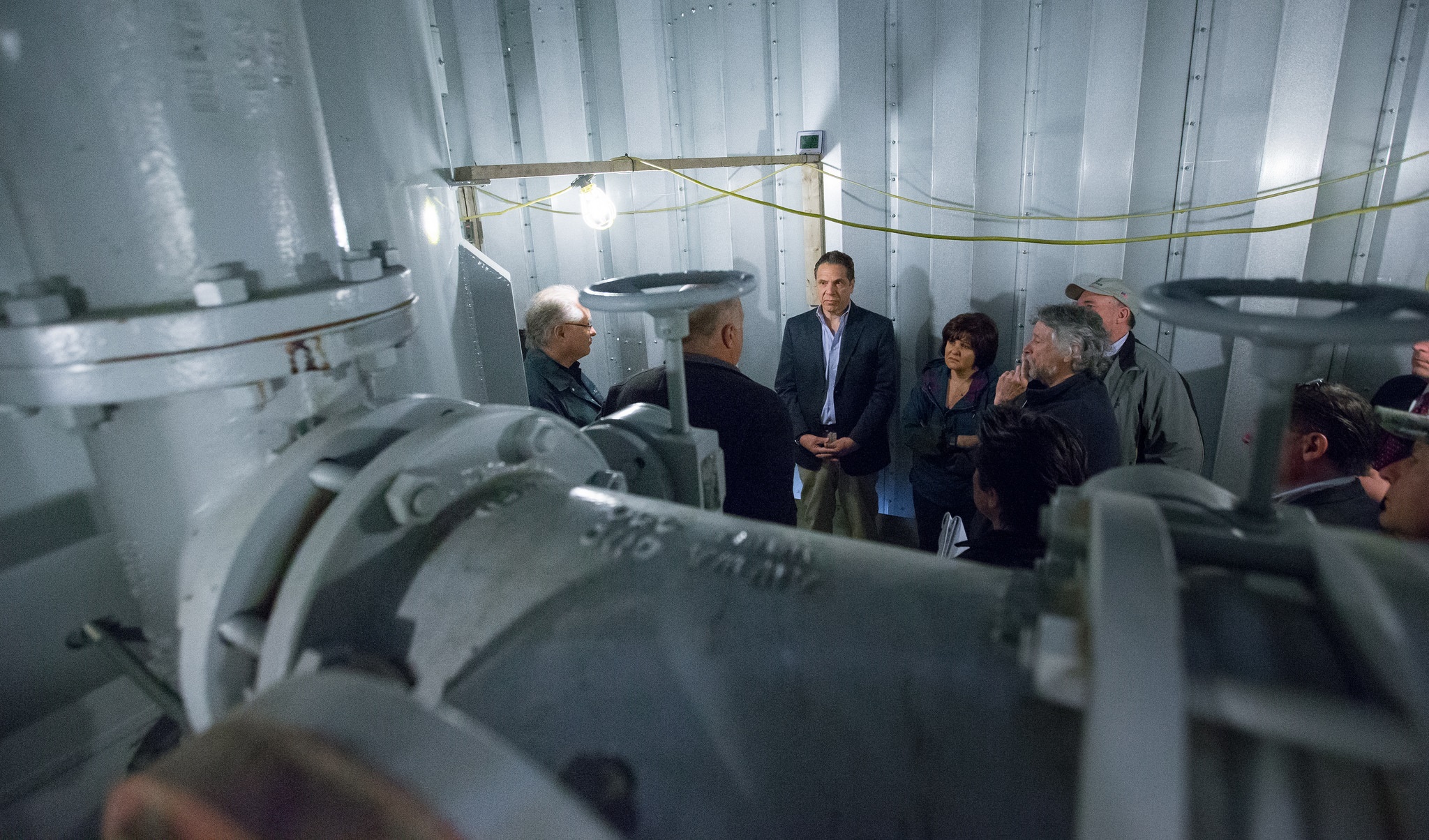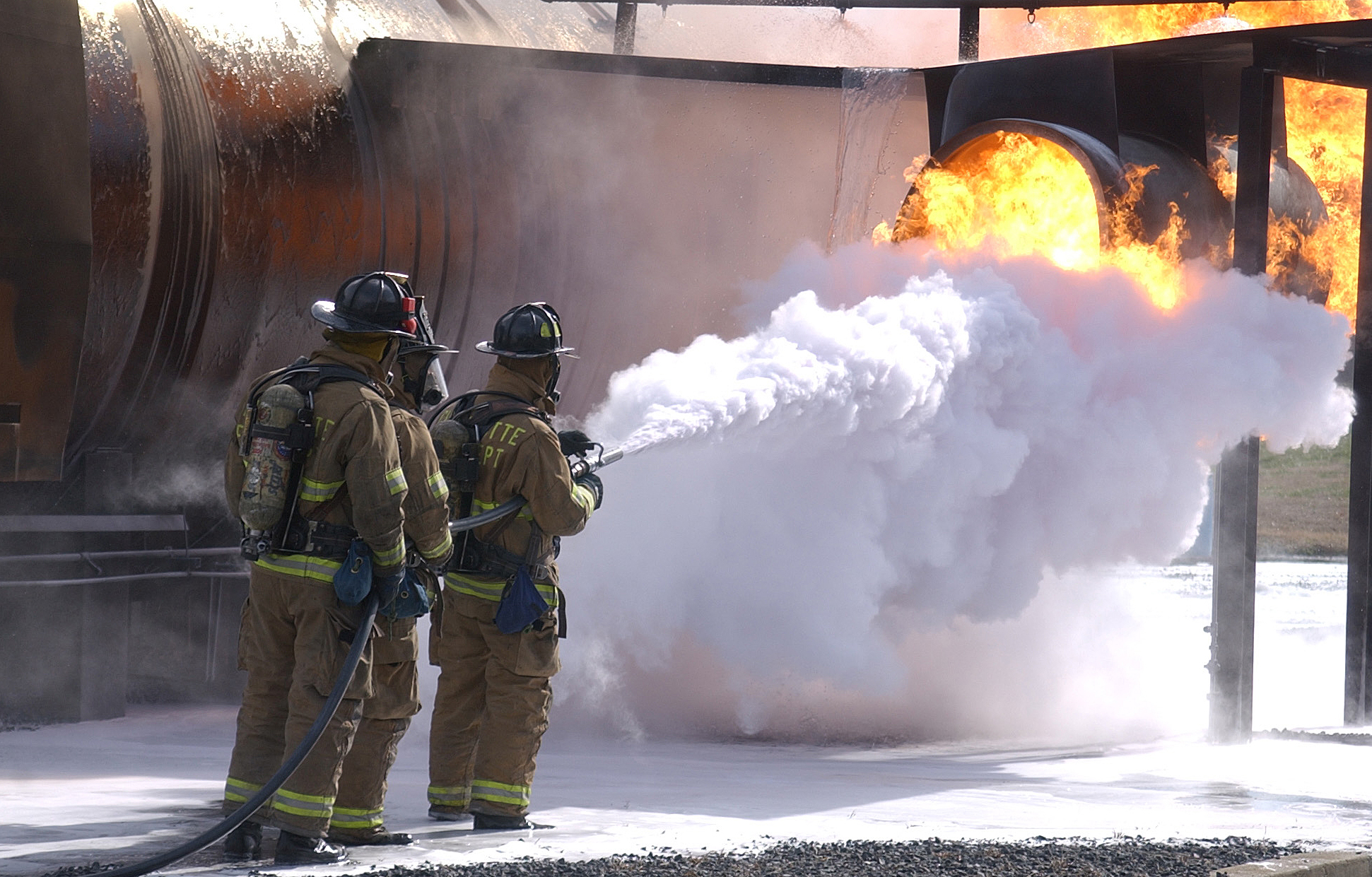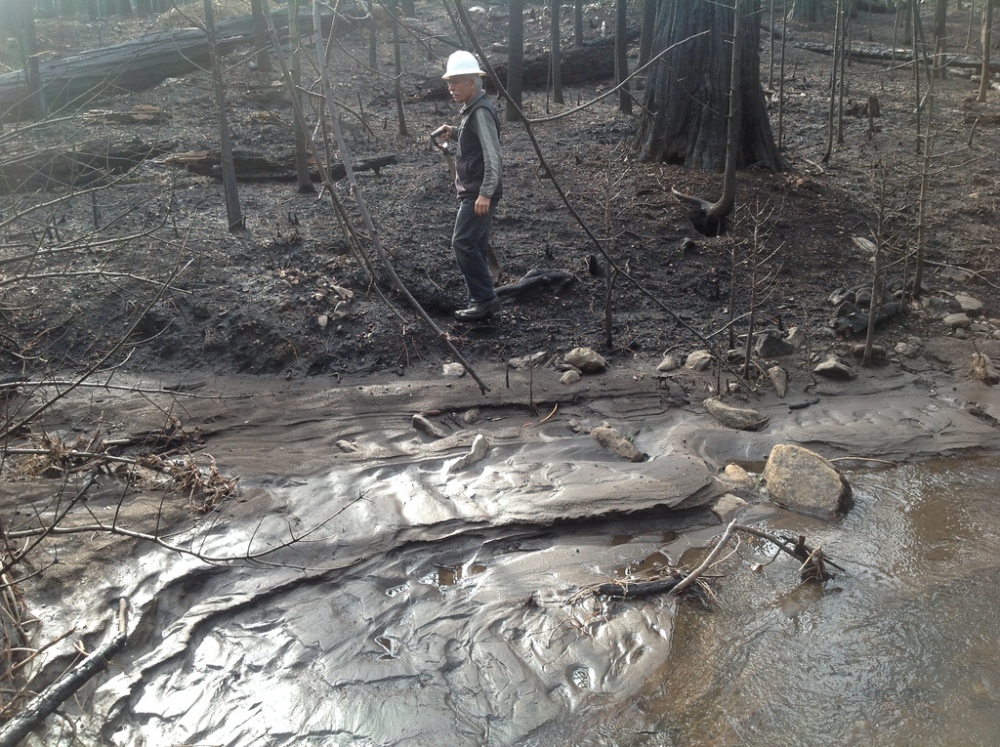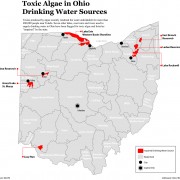Nonstick Chemicals Slipped Into Water, Causing Health, Environmental, Regulatory Mess
PFASs — used in clothing, carpets, cookware, and more — contaminate wells across the United States.

Gov. Andrew Cuomo of New York met with Hoosick Falls officials and other state authorities to tour the Village of Hoosick Falls water treatment plant in this March 2016 photo. The Hoosick Falls water source was contaminated with the chemical PFOA. Photo courtesy of New York Governor’s Office
By Brett Walton, Circle of Blue
The early 1990s were the start of a sizzling decade for ChemFab, a producer of specialized plastics. The company’s water-repelling, heat-resistant fabrics were everywhere. Beta cloth, an insulator, lined the payload bay of the Space Shuttle Columbia. The roofs of the Metrodome and Georgia Dome, professional sports stadiums in Minneapolis and Atlanta, were draped with fabric coated with PTFE, a slick polymer. BusinessWeek took notice, naming the Merrimack, New Hampshire-based firm a Hot 100 growth company in 1991 after profits climbed 185 percent in three years.
The good fortune kept going in 2000 when the French industrial giant Saint-Gobain, a world leader in plastics, purchased ChemFab. After the acquisition, the product line continued to impress. The Dallas Cowboys, self-proclaimed as America’s football team, now play home games at AT&T Stadium beneath 19,000 square meters of Saint-Gobain’s gossamer Sheerfill fabric, which covers the retractable roof.
In several New England states, though, the company’s shine has worn away in the last year. State officials identified Saint-Gobain’s Merrimack facility, along with sister production sites in New York and Vermont, as sources of chemical contamination of household wells and public drinking water supplies.
Perfluorinated alkyl substances, or PFASs, that were used in the manufacture of a number of consumer and industrial goods at the facilities were detected in groundwater above the level that the U.S. Environmental Protection Agency says is potentially damaging to human health. The contamination zone around the Merrimack facility spreads across 30 to 40 square miles, an area of nearly unprecedented size for groundwater pollution from a single site, according to Brandon Kernen, a hydrologist in the New Hampshire Department of Environmental Services, who is investigating water contamination.
Saint-Gobain’s chemical releases are part of a much larger problem. PFASs in groundwater have been traced across the country to military bases, fire stations, landfills, hospitals, and schools — large institutions that use foams, waxes, or cleaners that contain the chemicals. In fact, the closer regulators and scientists look at drinking water supplies, the more PFASs they find.
“It’s not another contaminant du jour,” Kernen says, noting the ubiquity of PFASs in household and industrial products and the tenacity with which they remain in the environment. “It’s something we’re going to be dealing with for quite a while.”
In short, the miracle compounds of 20th-century chemistry are causing an ecological, legal, and regulatory mess today. Like PCBs and pesticides, authorities are discovering how deeply another chemical that contributed to the ease and convenience of contemporary life has embedded itself in rivers, lakes, aquifers, and soils — as well as in human bodies.
In February, 3,500 residents sickened by the chemicals in Parkersburg, West Virginia, won a $US 671 million lawsuit against DuPont, which contaminated local water sources with PFAS waste for decades. Similar class-action lawsuits are being pursued against Saint-Gobain by residents of Hoosick Falls, New York, and Bennington, Vermont, and against firefighting foam manufacturers and military bases that used the foams by residents of two eastern Pennsylvania counties where wells have been tainted. Meanwhile, Lake Elmo, Minnesota, is suing chemical manufacturer 3M to recover millions of dollars the city spent on a new well and pipes after PFASs were found in an existing well.
The U.S. Government Accountability Office, the investigative arm of Congress, noted in a January 2017 report that the Defense Department will likely incur significant costs to clean up PFASs at military bases. Navy officials said that the price tag for cleaning up the chemicals at active and closed bases could be billions of dollars.
A Modern Problem
When chemists began producing them after World War Two, perfluorinated compounds — long chains of carbon bonded to fluorine atoms and other elements — were the industrial equivalent of a wonder drug. The compounds repelled water, stains, and dirt like invisible armor. They were strong, durable, and flexible. For a go-go society with a consumer economy set to boil, the chemical properties were a perfect match.
The market for PFASs cracked wide open. Sold under brand names such as Teflon, Gore-Tex, Scotchgard, and Stainmaster, PFASs were incorporated into a dazzling range of household products: nonstick skillets, water-repelling jackets, stain-resistant carpets, floor cleaners, waxes, paints, and insect traps. High-tech industries added them to circuit boards and semiconductors, automotive wiring and solar panels. Food packaging companies put them on pizza boxes, burger wrappers, and microwavable popcorn bags, to reject grease. Fire departments used them to put out oil fires.
Today, PFASs are earning a new reputation — as a health risk and a menace to drinking water.
Because the carbon-fluorine bond is one of the most stable in chemistry, PFASs do not easily break down. They linger; then, if consumed, they accumulate in the blood, liver, and kidneys. Human studies show that PFASs harm the development of a fetus, resulting in low birth weight and hormonal disruption. In studies of laboratory animals, they are also associated with cancers of the thyroid, liver, and pancreas.
Many of the human health effects are derived from a study of some 69,000 people in Ohio and West Virginia who lived near DuPont’s Washington Works production facility in West Virginia, and were exposed to PFOA in drinking water. PFOA is the perfluorinated compound used to make Teflon.
The C8 study — named for the eight carbon atoms in PFOA — found links between elevated PFOA levels in blood and a number of ailments: kidney cancer, high cholesterol, colitis, and thyroid disease.
Military Bases and Congressional Representatives on Notice
Industrial plants such as the DuPont Washington Works facility and 3M factories in Oakdale, Minnesota, and Decatur, Alabama, were among the first sites to be scrutinized. Military bases are a more recent target. Groundwater contamination at bases is widespread due to a certain type of foams — class B aqueous film forming foams — that are used to put out petroleum fires. James Brindle, a Defense Department spokesman, told Circle of Blue that the department does not yet have cleanup cost figures that it can release publicly.

Air Force officials answer questions from local media at Fire Station One during a roundtable at Peterson Air Force Base, Colorado, on November 2, 2016. The officials were visiting Peterson AFB to discuss perfluorinated compound contamination in the aquifer that Fountain, Security, and Widefield use for drinking water. Photo by U.S. Air Force / Rob Bussard
Brindle said that as of last November department officials had identified 356 active military installations and bases slated for closure that have one or more areas of suspected PFAS contamination due to firefighting foams. He said the contaminated areas are in various stages of assessment and response.
Members of Congress have taken up the cause. In March, Rep. Brian Fitzpatrick, a first-term Republican from Pennsylvania, asked the House committee that controls the Defense Department’s budget to fund a national health study and a cleanup of public and private wells contaminated by military bases. In his eastern Pennsylvania district, 22 public water supply wells and more than 140 household wells have been shut down because of PFAS contamination linked to two naval air stations and a National Guard air station.
New York’s Democratic senators, meanwhile, introduced legislation three days earlier to require the EPA to set maximum levels in drinking water for PFOA and PFOS, the best-known of the roughly 3,000 perfluorinated compounds on the market.
Alan Roberson, executive director of the Association of State Drinking Water Administrators, said that Congress, given that it passes only a fraction of the bills that are introduced each session, probably will not force EPA action on PFASs. That is unless public outcry becomes so fervid that lawmakers cannot ignore it: “Unless something explodes, unless PFASs become the new Flint,” Roberson told Circle of Blue.
No Federal Regulation
Federal authorities offer guidance to local officials for responding to evidence of contamination, but the EPA does not regulate PFASs in drinking water, nor has the agency listed the chemicals under federal statutes for hazardous waste cleanup. In May 2016, the EPA significantly lowered a non-binding health advisory for PFOA and PFOS, saying that a combined concentration in drinking water above 70 parts per trillion is dangerous to health, especially for women who are breast feeding.
The EPA also has proposed the Saint-Gobain facility in Hoosick Falls for Superfund designation. And the agency worked with industry to phase out production of PFOA and PFOS. In their place companies are using shorter-chain compounds, which are supposed to break down more easily but critics claim they have not been properly vetted.
The lack of federal standards, meanwhile, is confusing water providers. John Lovie, vice president of Whidbey Island Water Systems Association, a group of Washington state water utilities that is dealing with PFAS contamination of wells near Naval Air Station Whidbey Island, understands that the EPA is under difficult circumstances, but thinks that the health advisory did not provide enough guidance.
“People don’t know how to react,” he told Circle of Blue.

Certain firefighting foams used to put out oil fires have been linked to PFAS contamination of groundwater near fire stations and military bases. Photo by Tech Sgt Brian E. Christiansen, North Carolina Air National Guard Public Affairs
For the hundreds of small water systems on Whidbey — all but three of which serve fewer than 1,000 people — deciding whether to act is often a matter of dollars. “The money is just not there,” Lovie said. And, as seen in the thousands of PFAS chemicals, there is a universe of unregulated but potentially dangerous chemicals that will pose severe hardship if small systems must pay for treatment without financial assistance.
“It’s hard enough dealing with regulated contaminants,” Lovie said. “This foreshadows the issues that small systems are going to have with unregulated contaminants.”
The grey area between regulated and unregulated complicates the cleanup process, argue Jeff Kray and Sarah Wightman, lawyers at Marten Law, a firm that handles environmental cases. Without national standards “it will remain unnecessarily difficult for drinking water suppliers, owners of contaminated land, and others concerned about the potential public health consequences of PFASs to address the sources of PFAS contamination and recover cleanup costs from responsible parties.”
In the absence of federal rules, state leaders are on their own to set standards. A few have.
On February 16, a New Jersey Department of Environmental Protection science advisory body endorsed a 14 parts per trillion standard for PFOA and submitted the recommendation to the department’s commissioner. A decision whether to accept that standard and begin the rulemaking process is expected soon, according to Larry Hajna, department spokesman. The state is also developing a separate PFOS standard.
New Jersey has been sampling drinking water systems for PFASs for a decade. State officials, aware of several DuPont facilities within their jurisdiction, were spooked by the West Virginia C8 investigation, Hajna said. From 2006 to 2016 the state tested more than 1,000 water samples from 80 public water systems. PFASs were found in samples from 60 percent of the systems. Still, only now is the state acting — and the regulations affect drinking water providers not the chemical manufacturers.
If adopted, New Jersey’s standard would follow the lead of Vermont and New Hampshire, both of which operate under state-approved PFAS limits. New Hampshire has a groundwater standard that matches the EPA’s 70 parts per trillion health advisory, while Vermont’s is stricter, at 20 parts per trillion.
Blowing in the Wind
One of the most rigorous PFAS investigations today is taking place in New Hampshire. Just over a year ago, after the Saint-Gobain facility made headlines, the Department of Environmental Services used hazardous waste records and data on fire stations and landfills to identify about 20 sites in the state most at risk for PFAS contamination. Their findings to date reveal a dispersed but significant problem.
The Saint-Gobain site, for one, is unusual. When the PTFE-coated fabrics that were the source of the PFAS contamination were dried in the facility’s blower stacks, chemicals were lifted into the air. Once airborne, the particles eventually settled onto the ground where they dissolved in rain and were absorbed in the soil, eventually flowing downward into groundwater.
This sort of air deposition “blows up the traditional approach to investigating groundwater contamination,” which typically involves a land-based source with a defined flow pattern, Kernen said. “The wind blows every which way. It complicates the issue.”
Other tests showed the diversity of pollution pathways.
The Kingston Fire Department, for example, wanted to open its well to citizens during last summer’s drought as emergency water source. But state tests found the well exceeded the 70 parts per trillion standard for PFOA and PFOS, as did three private wells in the neighborhood. Firefighting foams are the suspected contamination source.
But that’s not all. Other wells near the Kingston fire station showed hundreds of parts per trillion of unregulated PFAS compounds, Kernen said. That presented an uncomfortable situation for state authorities when they explained the test results to the homeowners and could offer no recommendations for how to act. “We had to say ‘You meet drinking water standards, but we detected all this other stuff at these levels and we don’t have any health information for you,’” Kernen recalled.
At another site, near a car wash, testing of a monitoring well showed more than 9,000 parts per trillion of unregulated PFAS compounds. The car wash, not connected to a sewer, had a permit to discharge wastewater to groundwater. Officials told some 800 waste sites — landfills, hazardous materials, and facilities with groundwater discharge permits — to include PFAS sampling in their routine groundwater monitoring.
The state also collected voluntary samples from private well owners. Kernen noted one important trend: a relatively high number of positive detections from schools and health care facilities. The state has not done a scientific analysis, but Kernen’s hypothesis is that these places mop the floors every day and then dump the suds either down the drain, where they flow into a septic tank that percolates into the groundwater, or outside, where they also soak into groundwater. PFASs are a component of high-strength floor cleaners and waxes.
The cost of addressing the contamination is still unknown, partly because new problem areas keep emerging. New Hampshire has spent roughly $US 30 million on remediation projects, half of which went to the Saint-Gobain site. Some 500 homes whose wells were polluted were connected to a public water system. At least 600 homes have been put on bottled water. The state is trying to recover its costs from Saint-Gobain. A company spokeswoman would not comment on the financial details but noted that Saint-Gobain will fund the design work to extend public water to 61 properties in the town of Bedford.
Brett writes about agriculture, energy, infrastructure, and the politics and economics of water in the United States. He also writes the Federal Water Tap, Circle of Blue’s weekly digest of U.S. government water news. He is the winner of two Society of Environmental Journalists reporting awards, one of the top honors in American environmental journalism: first place for explanatory reporting for a series on septic system pollution in the United States(2016) and third place for beat reporting in a small market (2014). He received the Sierra Club’s Distinguished Service Award in 2018. Brett lives in Seattle, where he hikes the mountains and bakes pies. Contact Brett Walton










